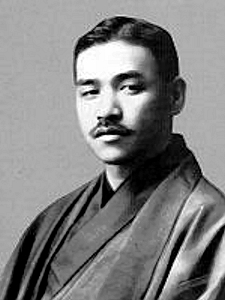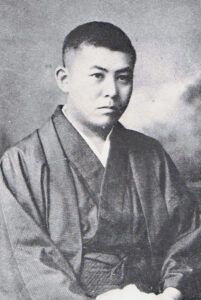When Lafcadio Hearn taught English literature at Tokyo Imperial University (the current University of Tokyo), he praised a certain undergraduate as “the only one that can express himself in English among 10,000 Japanese students.”
The prodigy worth such high praise was Bin Ueda. Born in 1874 at Tsukiji, Tokyo, he enriched his knowledge at Tokyo Eigo Gakko (Tokyo English School) and the First Higher School (precursor of University of Tokyo and Chiba University), before entering the top university in Japan.

Remarkably Ueda had a good command of French, German and Spanish as well as English, and he began to rise to fame after graduation. He came out with Kaicho-on (The Sound of the Sea Tide), a collection of translations of works by French poet Paul Verlaine, German poet Carl Busse and English writers such as William Shakespeare and Robert Browning.
In 1908, he was appointed to be a professor at Kyoto Imperial University, the current Kyoto University. Initially, he stayed at Shigaraki, a ryokan that stood near the Sanshi Suimeisho arbor in Kamigyo-ku, and afterward settled in the northern vicinity of Heian Jingu.
Ueda was one of the earliest readers of Jun’ichiro Tanizaki, and invited the novelist in 1912 when he was on a business trip to Kyoto. The professor was recollected by the literary giant about two decades later:
Judging from the erudition shown in my favorite books of his, such as Shisei Dante [Ueda’s translations of the poetry of Dante], I imagined that he must look like a very aged and fashionable Western professor. Apart from his dark moustache, however, [Bin Ueda] Sensei looked like neither a typical scholar nor a typical man of letters. Rather, he appeared to be either the owner of a large store in shitamachi (old downtown area) or a proper gentleman like a merchant.
― Extract from Seishun Monogatari (My Adolescent Days) by Jun’ichiro Tanizaki

Meanwhile, Ueda was such a strong magnet for bibliophiles that some students enrolled in Kyoto Imperial University just to listen to his lectures. Among the listeners was Yoshio Yamanouchi, who, in later years, formed a friendship with French diplomat Paul Claudel as well as translating André Gide’s Strait is the Gate (La Porte Étroite) into Japanese.
Another remarkable student of Ueda was Kan Kikuchi, who later founded the publishing company Bungei Shunju. The professor greatly supported Kikuchi with his research on Irish playwright John Millington Synge.
The distinguished scholar must have been expected to assist up-and-coming students for more years to come. However, illness dashed his hopes; he had a fit during the end-stage of renal disease in July, 1916, which claimed his life. He was only 41 years old.
Ueda’s passing was mourned by his academic colleagues and former students. For example, one of his juniors sorrowfully conveyed the distressing news as follows:
[Bin Ueda] Sensei was practically the most precious figure amongst present-day Japanese. The loss of Sensei is the loss of a greater part of Kyoto Imperial University’s raison d’etre.
― Extract from ‘Ueda Bin Sensei no Koto’ (Regarding Professor Bin Ueda) by Kan Kikuchi (1916)
Indeed Ueda’s sudden death caused an enormous shock, but Kyoto Imperial University successfully handed on its academic torch by inviting professors such as Tatsuo Kuriyagawa and Edward Bramwell Clarke.
Ueda rests in Yanaka Cemetery in Tokyo. Like the capital, Kyoto has lost many of the places associated with the professor. That said, if you visit the vicinity of Keage Incline, you can find a good reminder: Hyotei is a 400-year-old restaurant, where the professor went with Tanizaki and his friend Mikihiko Nagata, lyricist of the song ‘Gion Kouta’. The elegant dining establishment is for sure the place to go if you hope to enjoy the way Ueda spent time with his friends.
- Further reading
Lafcadio Hearn on Bin Ueda
Bin Ueda and Jun’ichiro Tanizaki:
Seishun Monogatari (1932-1933) by Jun’ichiro Tanizaki: - “Ueda Bin Sensei no Koto (About Professor Bin Ueda)” by Kan Kikuchi in August issue of “Shin Shicho” (1916)
Links to the photos:
Photo of Bin Ueda
Photo of Jun’ichiro Tanizaki in 1913
